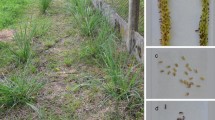Abstract
Haploids (tetraploids and triploids) were obtained from crosses between colchicine-doubled octaploid and natural hexaploid Mexican potato species and the Gp. Phureja clone 1.22 as the pollinator, but none were obtained from crosses of natural 4x(2EBN) Mexican species with 2x(1EBN) pollinators. The manipulation of ploidy and Endosperm Balance Number (EBN) of tetraploid Mexican potato species was useful in explaining the occurrence of pseudogamous parthenogenetic haploid production. The pollinator effect, EBN, and maternal influence are important characters to consider in searching for haploid-inducing pollinators among 2x(2EBN) as well as 2x(1EBN) potato species.
Compendio
Se obtuvieron haploides (tetraploides y triploides) de cruzamientos entre octoploides doblados con colchicina y especies hexaploides naturales de papa mexicana y el clone 1.22 del Gp. Phureja como polinizador, pero no se obtuvo ninguno de cruzamientos de especies mexicanas naturales 4x (2EBN) con polinizadores 2x(1EBN). La manipulación de la ploidia y del Numero de Balance del Endosperma (EBN) de especies tetraploides de papa mexicana fue útil para explicar la producción de haploides partenogenéticos pseudogamos. El efecto del polinizador, EBN, y la influencia materna son características importantes a considerar en la búsqueda de polinizadores inductores de haploides entre especies de papa 2x(2EBN) así como entre las especies 2x(1EBN).
Similar content being viewed by others
Literature Cited
Brink, R.A. and D.C. Cooper. 1947. The endosperm in seed development. Bot Rev 13:423–541.
Hermsen, J.G.Th. 1969. Induction of haploids and aneuploids in colchicine-induced tetraploidSolanum chacoense Bitt. Euphytica 18:183–189.
Hermsen, J.G.Th. 1971. Tetraploids from colchicine-induced octaploidSolanum acaule subsp.aemulans. Euphytica 20:490–492.
Hougas, R.W., S.J. Peloquin and R.W Ross. 1958. Haploids of common potato. J Hered 49:103–106.
Johnston, S.A., T.P.M. den Nijs, S.J. Peloquin and R.E. Hanneman, Jr. 1980. The significance of genic balance to endosperm development in interspecific crosses. Theor Appl Genet 57:5–9.
Latev, J.P. and R.S. Dvorjankina. 1969. [Haploids ofSolanum demissum Lindl.]. Genetika 5:187–189. (In Russian). (Plant Breed Abstr 50:1094, 1970).
Montelongo-Escobedo, H. and P.R. Rowe. 1969. Haploid induction in potato: cytological basis for pollinator effect. Euphytica 18:116–123.
Nishiyama, I. and N. Inomata. 1966. Embryological studies on cross incompatibility between 2x and 4x inBrassica. Jpn J Genet 41:27–42.
Nishiyama, I. and T. Yabuno. 1978. Causal relationships between the polar nuclei in double fertilization and interspecific cross-incompatibility inAvena. Cytologia 43:453–466.
Ross, R.W., L.A. Dionne and R.W. Hougas. 1967. Doubling the chromosome number of selectedSolanum genotypes. Eur Potato J 10:37–52.
Sarkar, K.R. and E.H. Coe, Jr. 1971. Anomalous fertilization in diploid-tetraploid crosses in maize. Crop Sci 11:539–542.
Singsit, C. and R.E. Hanneman, Jr. 1991. Rescuing abortive inter-EBN potato hybrids through double pollination and embryo culture. Plant Cell Rep 9:475–478.
van Breukelen, E.W.M. 1981. Pseudogamic production of dihaploids and monohaploids inSolanum tuberosum and some related species. Centre for Agricultural Publishing and Documentation, Wageningen, pp. 1–121.
von Wangenheim, K.H. 1957. Untersuchungen über den Zusammenhang zwischen Chromosomenzahl and Kreuzbarkeit bei Solanum-Arten. Z Indukt Abst Vererbungsl 88:21–37.
von Wangenheim, K.H., S.J. Peloquin and R.W. Hougas. 1960. Embryological investigations on the formation of haploids in the potato (Solanum tuberosum). Z Vererbungsl 91:391–399.
Author information
Authors and Affiliations
Additional information
Cooperative investigation of Vegetable Crops Research Unit, USDA, Agricultural Research Service and the Wisconsin Experiment Station. Supported in part by USDA/Cooperative States Research Service Competitive Grant No. 83-CRCR-1-1253.
Rights and permissions
About this article
Cite this article
Singsit, C., Hanneman, R.E. Haploid induction in Mexican polyploid species and colchicine-doubled derivatives. American Potato Journal 68, 551–556 (1991). https://doi.org/10.1007/BF02853772
Accepted:
Issue Date:
DOI: https://doi.org/10.1007/BF02853772




